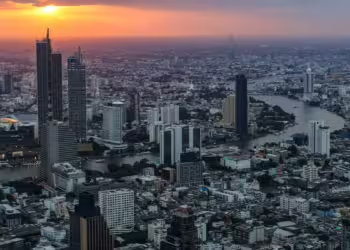No products in the basket.
COVID-19 has delivered a triple shock to the developing East Asia and Pacific (EAP) region: the pandemic itself, the economic impact of containment measures, and reverberations from the global recession brought on by the crisis.
It will need swift action to ensure that the pandemic does not hamper growth and increase poverty for years to come, according to From Containment to Recovery, the World Bank’s October 2020 Economic Update for East Asia and the Pacific.
Domestic economic activity is reviving in some countries that have so far contained the spread of the virus. But the region’s economy heavily depends on the rest of the world, and global demand remains subdued.
The region as a whole is expected to grow by only 0.9 percent in 2020, the lowest rate since 1967. While China is forecast to grow by 2.0 percent in 2020 – boosted by government spending, strong exports, and a low rate of new COVID-19 infections since March, but checked by slow domestic consumption – the rest of the EAP region is projected to contract by 3.5 percent.
Thailand’s baseline and lowercase GDP growth projections are now as low as -8.3% and -10.4%.
An important lesson from the crisis to date is that countries with well-functioning social protection programs and good implementation infrastructure, pre-COVID, have been able to scale up more quickly during the pandemic.
Thailand’s ability to identify, screen, and provide support to millions of previously uncovered workers and farmers is also built on a robust national ID system, broad digital-mobile infrastructure, and sound information systems.
Brighter prospects in 2021
Prospects for the region are brighter in 2021, with growth expected to be 7.9 percent in China and 5.1 percent in the rest of the region, based on the assumption of continued recovery and normalisation of activity in major economies, linked to the possible arrival of a vaccine.
However, output is projected to remain well below pre-pandemic projections for the next two years. The outlook is particularly dire for some highly exposed Pacific Island Countries where output is projected to remain about 10 percent below pre-crisis levels through 2021.
Poverty in the region is projected to increase for the first time in 20 years: as many as 38 million people are expected to remain in, or be pushed back into, poverty as a result of the pandemic (based on the upper-middle income poverty line of $5.50 a day).
In the wake of COVID-19, EAP governments have, on average, committed nearly 5 percent of their GDP to strengthen public health systems, support households, and help firms to avoid bankruptcy. However, several countries have found it hard to scale up their limited social protection programs, on which they previously spent less than 1 percent of GDP, and continued support will put pressure on government revenue bases.
“COVID-19 is not only hitting the poor the hardest, it is creating ‘new poor.’ The region is confronted with an unprecedented set of challenges, and governments are facing tough choices,” said Victoria Kwakwa, Vice President for East Asia and the Pacific at the World Bank. “But there are smart policy options available that can soften these tradeoffs – such as investing in testing and tracing capacity and durably expanding social protection to cover the poor and the informal sector.”
The report warns that without action on multiple fronts, the pandemic could reduce regional growth over the next decade by 1 percentage point per year, with the greatest impacts being felt by poor households, because of lower levels of access to healthcare, education, jobs, and finance.
School closures due to COVID-19 could result in a loss of 0.7 learning-adjusted years of schooling in EAP countries, according to analysis in the report. As a result, the average student in the region could face a reduction of 4 percent in expected earnings every year of their working lives.
Public and private indebtedness, along with worsening bank balance sheets and increased uncertainty, pose a risk to public and private investment, as well as to economic stability – at a time when the region urgently needs both.
Large fiscal deficits in EAP to increase government debt
World Bank projects large fiscal deficits in EAP to increase government debt on average by 7 percent of GDP in 2020. The report calls for fiscal reform to mobilise revenue through more progressive taxation and less wasteful spending. In some countries, the stock of outstanding debt might already be unsustainable and require greater external support.
At the same time, the crisis is accelerating pre-existing trends in trade, including regionalisation in EAP, a relocation of some global value chains away from China, and faster growth in digitally delivered services, but also increasing pressure to revert to protectionism.
“Many EAP countries have been successful in containing the disease and providing relief, but they will struggle to recover and grow,” said Aaditya Mattoo, Chief Economist for East Asia and the Pacific at the World Bank. “The priorities now should be safe schooling to preserve human capital; widening narrow tax bases to avoid cuts in public investment; and reform of protected service sectors to take advantage of emerging digital opportunities.”
Discover more from Thailand Business News
Subscribe to get the latest posts sent to your email.













